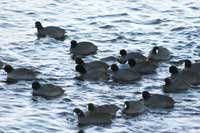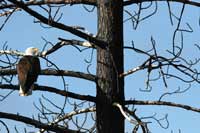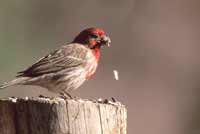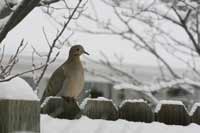This year represents the 115th annual Christmas Bird Count, better known as the “CBC.” Held one day during a two-week period between December 14 and January 5, this is the longest running citizen-science survey in the world. Thousands of participants in over 2,300 count circles across different nations will take to the field or watch their backyard for birds.
 The count provides researchers with a huge data set to analyze long-term population trends, local fluctuations and winter distribution of birds. Combined with the North American Breeding Bird Surveys, held in late spring and early summer, noted shifts in bird populations and winter range occupation may indicate responses to habitat changes or climatic variation. Local population changes may be linked with hunting pressure or habitat fragmentation and provide a snapshot of overall health. There have been numerous reports, scientific publications and conservation strategies that have come out of the simple pleasures that birders experience spending a day in the field counting birds.
The count provides researchers with a huge data set to analyze long-term population trends, local fluctuations and winter distribution of birds. Combined with the North American Breeding Bird Surveys, held in late spring and early summer, noted shifts in bird populations and winter range occupation may indicate responses to habitat changes or climatic variation. Local population changes may be linked with hunting pressure or habitat fragmentation and provide a snapshot of overall health. There have been numerous reports, scientific publications and conservation strategies that have come out of the simple pleasures that birders experience spending a day in the field counting birds.
The 15-mile diameter Moab count circle includes most of the Moab and Spanish Valley,  and stretches out to portions of Sand Flats, Castle Valley, the Colorado River corridor and Arches National Park. To provide adequate coverage of these areas, small groups of birders visit pre-defined zones. This eliminates duplication and allows for the groups to thoroughly search an area for birds. Backyard feeder watchers can also contribute to the count.
and stretches out to portions of Sand Flats, Castle Valley, the Colorado River corridor and Arches National Park. To provide adequate coverage of these areas, small groups of birders visit pre-defined zones. This eliminates duplication and allows for the groups to thoroughly search an area for birds. Backyard feeder watchers can also contribute to the count.
During past counts, I was always amazed at the numbers and diversity of species a neighborhood might hold. Whereas if I’d driven down the road I would have missed many individuals; however, on foot I could scan the trees and stop to look at birds visiting a backyard feeder. Of course, I might get a few stares from the homeowners trying to figure who the heck this guy with binoculars staring into their backyard might be. If they came out to investigate, I’d take the opportunity to tell them about the count, ask what birds were visiting their feeders and reassure them I was stalking the creepers, not a creepy stalker.
 For the entire circle, a species list of around 70 birds is a productive count; the 114th count turned up 76. This diversity is a reflection of the different habitats found within the count area. Some species might be represented by a lone individual, like last year’s merlin, a small falcon noted for its speed and hunting prowess. In contrast, white-crowned sparrows numbered over 700 individuals.
For the entire circle, a species list of around 70 birds is a productive count; the 114th count turned up 76. This diversity is a reflection of the different habitats found within the count area. Some species might be represented by a lone individual, like last year’s merlin, a small falcon noted for its speed and hunting prowess. In contrast, white-crowned sparrows numbered over 700 individuals.
Other interesting sightings were a lone turkey vulture, two ferruginous hawks, western screech and northern pygmy owls, and Lincoln’s and Harris’ sparrows. An American tree sparrow and some evening grosbeaks were also highlights.
 I’ve learned that each year is different than the last, that expectations are often dashed and that the weather can be a huge factor. Standing around trying to identify shrub-lurking sparrows can be a daunting proposition at 20° F. Dressing for conditions is important, especially considering the amount of time spent outside. An unplanned pit stop or thermos of hot drinks can bolster any birder’s enthusiasm for continuing versus calling it a day.
I’ve learned that each year is different than the last, that expectations are often dashed and that the weather can be a huge factor. Standing around trying to identify shrub-lurking sparrows can be a daunting proposition at 20° F. Dressing for conditions is important, especially considering the amount of time spent outside. An unplanned pit stop or thermos of hot drinks can bolster any birder’s enthusiasm for continuing versus calling it a day.
If you’d like to join this year’s count, contact Marcy Hafner at 435-259-6197 or marcymoab@yahoo.com. The following day, December 21, there will be a potluck breakfast and count rundown at The Nature Conservancy office, 900 W. Kane Creek Blvd, starting at 10 a.m.

 The count provides researchers with a huge data set to analyze long-term population trends, local fluctuations and winter distribution of birds. Combined with the North American Breeding Bird Surveys, held in late spring and early summer, noted shifts in bird populations and winter range occupation may indicate responses to habitat changes or climatic variation. Local population changes may be linked with hunting pressure or habitat fragmentation and provide a snapshot of overall health. There have been numerous reports, scientific publications and conservation strategies that have come out of the simple pleasures that birders experience spending a day in the field counting birds.
The count provides researchers with a huge data set to analyze long-term population trends, local fluctuations and winter distribution of birds. Combined with the North American Breeding Bird Surveys, held in late spring and early summer, noted shifts in bird populations and winter range occupation may indicate responses to habitat changes or climatic variation. Local population changes may be linked with hunting pressure or habitat fragmentation and provide a snapshot of overall health. There have been numerous reports, scientific publications and conservation strategies that have come out of the simple pleasures that birders experience spending a day in the field counting birds. and stretches out to portions of Sand Flats, Castle Valley, the Colorado River corridor and Arches National Park. To provide adequate coverage of these areas, small groups of birders visit pre-defined zones. This eliminates duplication and allows for the groups to thoroughly search an area for birds. Backyard feeder watchers can also contribute to the count.
and stretches out to portions of Sand Flats, Castle Valley, the Colorado River corridor and Arches National Park. To provide adequate coverage of these areas, small groups of birders visit pre-defined zones. This eliminates duplication and allows for the groups to thoroughly search an area for birds. Backyard feeder watchers can also contribute to the count. For the entire circle, a species list of around 70 birds is a productive count; the 114th count turned up 76. This diversity is a reflection of the different habitats found within the count area. Some species might be represented by a lone individual, like last year’s merlin, a small falcon noted for its speed and hunting prowess. In contrast, white-crowned sparrows numbered over 700 individuals.
For the entire circle, a species list of around 70 birds is a productive count; the 114th count turned up 76. This diversity is a reflection of the different habitats found within the count area. Some species might be represented by a lone individual, like last year’s merlin, a small falcon noted for its speed and hunting prowess. In contrast, white-crowned sparrows numbered over 700 individuals.  I’ve learned that each year is different than the last, that expectations are often dashed and that the weather can be a huge factor. Standing around trying to identify shrub-lurking sparrows can be a daunting proposition at 20° F. Dressing for conditions is important, especially considering the amount of time spent outside. An unplanned pit stop or thermos of hot drinks can bolster any birder’s enthusiasm for continuing versus calling it a day.
I’ve learned that each year is different than the last, that expectations are often dashed and that the weather can be a huge factor. Standing around trying to identify shrub-lurking sparrows can be a daunting proposition at 20° F. Dressing for conditions is important, especially considering the amount of time spent outside. An unplanned pit stop or thermos of hot drinks can bolster any birder’s enthusiasm for continuing versus calling it a day.